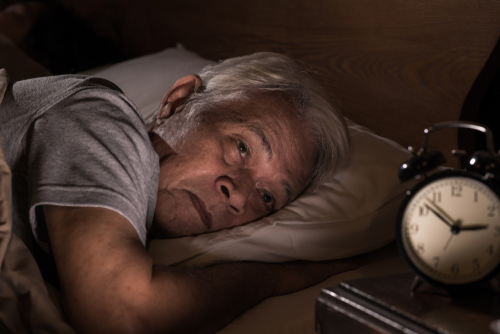Restless Legs and Dementia
Category:

Restlessness in elderly patients is often misunderstood. Older adults who experience nighttime sleep disturbances have difficulty functioning in the daytime. Lack of sleep can lead to agitation, increased confusion, depression, anxiety, and reduced quality of life.
So, what are some causes of restlessness in elderly people and what can caregivers do to help alleviate it?
Restless Legs Syndrome (RLS), also known as Willis-Ekbom Disease, is a common sensorimotor sleep-related movement disorder characterized by an urge to move the legs because of unpleasant sensations. It is characterized by an irresistible urge to move the legs to stop the feeling of tingling, or “bugs crawling” on or beneath the skin. Some people have described it as feeling the sensation of an electrical charge running through their legs.
Dementia and Restless Legs Syndrome are two conditions that often occur in the elderly population. If a person has dementia and cannot communicate effectively regarding their symptoms, it can be difficult for the physician to make an accurate diagnosis. Caregivers should be aware of symptoms so their loved one is not misdiagnosed.
Symptoms of Restless Legs Syndrome:
- Rubbing or kneading the legs.
- Grimacing or groaning while holding the legs.
- Excessive movement in the lower extremities such as kicking or rubbing the legs back and forth while in bed or in a reclining position.
- Excessive motor activity in the lower extremities, such as the need to walk or incessant pacing.
- Leg discomfort that is more prevalent during periods of inactivity and seems better if the person is up and moving around.
- Symptoms get worse in the evening or at night.
People with RLS must move their limbs constantly to offset the uncomfortable sensations in their legs. Dementia complicates the problem because the patient may begin to leave the house at night or wander inappropriately trying to relieve the distressing feelings in the limbs.
If your loved one exhibits any of these indicators, you should report the symptoms to the doctor to obtain a diagnosis and possible relief from the symptoms.
If left untreated, RLS can not only cause sleep disturbances, but can also lead to difficulty during sedentary activities, such as riding in the car, sitting down for a meal, going to a movie, or relaxing on the patio on a warm summer day.
What if you observe not only Restless Leg Syndrome but whole-body involvement?
Typically, RLS only affects the lower extremities. Sometimes it can develop in other parts of the body like the arms, neck, or torso. If this happens, it is usually an indication that the condition is worsening.
What are some treatment options for RLS?
There are both non-medicinal and pharmaceutical treatments for RLS. Most people try the non-medicinal route first.
The following lifestyle changes might help alleviate symptoms:
- Massage the legs to relax the muscles.
- Soak in a warm tub.
- Apply warm or cool packs to the affected limbs.
- Avoid stimulants such as over-the-counter drugs (without checking with your doctor) and caffeine, nicotine, and alcohol.
- Establish an exercise routine.
- Use a foot wrap or vibrating pad.
- Try to develop a sleep routine and stick to it.
- Ask your physician to check for underlying conditions, such as iron deficiency, that might be causing the symptoms.
Download Our Early Signs of Dementia Guide
If these suggestions don’t provide relief, make an appointment with your physician to analyze your symptoms.
There is no cure for Restless Legs Syndrome, but your medical professional can suggest medicines or supplements that many people find helpful in treating the condition.
Subscribe
Date: June 7, 2022
Category:


